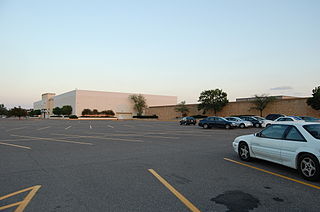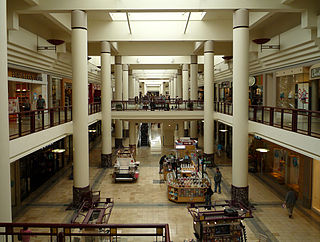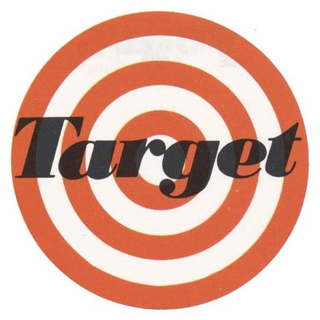Nicollet Mall is a twelve-block portion of Nicollet Avenue running through downtown Minneapolis, Minnesota, United States. It is a shopping and dining district of the city, and also a pedestrian mall and transit mall. Along with Hennepin Avenue to the west, Nicollet Mall forms the cultural and commercial center of Minneapolis.

The J. L. Hudson Company was an upscale retail department store chain based in Detroit, Michigan. Hudson's flagship store, on Woodward Avenue in Downtown Detroit, was the tallest department store in the world in 1961, and, at one time, claimed to be the second-largest department store, after Macy's, in the United States, by square footage.

Southdale Center is a shopping mall located in Edina, Minnesota, a suburb of the Twin Cities. It opened in 1956 and is both the first and the oldest fully enclosed, climate-controlled shopping mall in the United States. Southdale Center has 1,297,608 square feet of leasable retail space, and contains 106 retail tenants. The mall is owned by Simon Property Group and the anchor stores are Macy's, Dave & Buster's, AMC Theatres, Hennepin Service Center, and Life Time Athletic.

Columbia Mall is an enclosed regional shopping mall in Grand Forks, North Dakota located at the intersection of 32nd Avenue South and Columbia Road. The mall opened in 1978, and was developed by the Dayton Hudson Corporation at a cost of roughly $20 million. Today, Columbia Mall features the traditional retailers JCPenney and Scheels, and also currently features several prominent specialty retailers which are American Eagle, Bath and Body Works, Hot Topic, Maurices, Men's Warehouse, and Zumiez. GK Development, Inc. of Barrington, Illinois, is the current owner of the mall.

The Eden Prairie Center is a mall located in Eden Prairie, Minnesota. It has been managed by Jones Lang LaSalle as of 2020. It is anchored by JCPenney, Kohl's, Target, Von Maur and Scheels Sporting Goods.

Kirkwood Mall is an enclosed regional shopping mall in the city of Bismarck, North Dakota. At 850,000 square feet, Kirkwood Mall is the second largest mall in North Dakota, boasting over 90 shops. Opened in 1970, it is also the largest shopping center in the city. The mall's anchor stores are I. Keating Furniture & Flooring, Ashley HomeStore, Scheels All Sports, JCPenney, and Target. There is 1 vacant anchor store that was once Herberger's. The mall is located in the downtown district.

B. Dalton Bookseller was an American retail bookstore chain founded in 1966 by Bruce Dayton, a member of the same family that operated the Dayton's department store chain. B. Dalton expanded to become the largest retailer of hardcover books in the United States, with 779 stores at the peak of the chain's success. Located mainly at indoor shopping malls, B. Dalton competed primarily with Waldenbooks. Barnes & Noble acquired the chain from Dayton's in 1987 and continued to operate it until a late 2009 announcement that the last 50 stores would be liquidated by January 2010. B. Dalton was later revived by rebranding a Barnes & Noble location in 2022.
The Powers Department Store of Minneapolis, Minnesota was a department store chain with roots dating to 1873, and that, at its peak, consisted of 7 locations in Minnesota.
Apache Mall is a shopping mall in Rochester, Minnesota, United States. Apache Mall is owned and managed by Brookfield Properties, who acquired General Growth Properties in 2018. The mall's anchor stores are Scheels All Sports, Barnes & Noble, Macy's, and JCPenney. Boston Shoe & Boot Repair, Orangetheory Fitness, and Men's Wearhouse are junior anchors. There is 1 vacant anchor store that was once Herberger's. In 2014, the mall's Sears store was closed. However, shortly after the Sears was shut down, plans for a Scheels All Sports were announced, as well as an expansion of the building. Scheels opened in 2015. On April 18, 2018, it was announced that Herberger's would be closing as parent company The Bon-Ton Stores was going out of business. The store closed on August 29, 2018.

Burnsville Center is located in Burnsville, Minnesota. It is one of the larger enclosed malls in Minnesota with 100 stores on 3 floors and approximately 1,100,000 square feet (100,000 m2). The mall opened in 1977 with three anchor stores, Sears, Dayton's, and Powers Dry Goods as anchors.
Donaldson's, previously known as the L. S. Donaldson Company, headquartered in Minneapolis, Minnesota, is a defunct department store company.
Crossroads Center is a shopping mall in St. Cloud, Minnesota, United States, and is the largest mall in the state outside the core Twin Cities metro area. Its six anchor stores are Macy's, JCPenney, Target, Scheels All Sports, HomeGoods, and DSW Inc. The Marshall Field's store (originally Dayton's was officially renamed Macy's on September 9, 2006.

Ridgedale Center, colloquially known as Ridgedale, is an enclosed shopping mall in Minnetonka, Minnesota, a western suburb of the Twin Cities. It is directly located off I-394/US 12 between Ridgedale Drive and Plymouth Road. Ridgedale Center comprises 1,105,337 square feet (100,000 m2) of leaseable retail space, and contains approximately 140 retail tenants. It is currently jointly owned by Brookfield Properties and CBRE Group, and managed by Brookfield. The anchor stores are JCPenney, Nordstrom, Macy's, and Dick's House of Sport.

Northtown Mall is a shopping mall located in Blaine, Minnesota, United States. The mall's anchor stores are Hobby Lobby, Best Buy Outlet, 2 Becker Furniture World stores, and Burlington. In addition, Northtown Mall features over 100 stores and restaurants, as well as a food court and Paladin Career and Technical High School public charter school which was open in September 2002. The mall is owned by 4th Dimension Propertes. Over 5.5 million people visit the mall every year.
Shingle Creek Crossing, formerly Brookdale Center, is a regional shopping mall in Brooklyn Center, Minnesota. It became the third enclosed shopping mall in the Twin Cities, after Southdale Center and Apache Plaza. The mall opened in phases beginning with Phase One in March 1962 which included anchor stores Sears and JCPenney. Phase Two opened in 1966, adding Dayton's as the third anchor. Donaldson's became the fourth anchor in September 1967. Brookdale Center was part of "The Dales", what was referred to as the four "Dale" centers circling the Twin Cities, originally developed by Dayton-Hudson Corporation. The others are Southdale Center in Edina, Rosedale Center in Roseville and Ridgedale Center in Minnetonka. After a long decline, the mall closed in 2010 and was demolished in 2012 before being redeveloped into the Shingle Creek Crossing development.

Rosedale Center, commonly known just as Rosedale, is a shopping center in Roseville, Minnesota. The mall is surrounded by suburbs and close to major highways and serves a trade area population almost 2 million people, and boasts 14 million visitors annually.

Maplewood Mall is a super-regional shopping mall in Maplewood, Minnesota, United States. It is near Interstate 694 on the Saint Paul side of the Twin Cities metropolitan area. Maplewood Mall opened in 1974. It was later renovated and expanded in 1996. It is managed by Washington Prime Group of Columbus, Ohio. The mall's anchor stores are Barnes & Noble, JCPenney, Kohl's, and Macy's with one vacant anchor last occupied by Sears.

Silver Lake Village is a mixed-use development in the city of St. Anthony, Minnesota, United States. It was constructed beginning in 2004 as a $150 million plan to replace Apache Plaza, an aging enclosed mall. Its design is meant to resemble a "walkable community", as its development includes housing, shopping, dining, and other services. Its name is derived from Silver Lake, located just north of the development, and from St. Anthony's nickname of "St. Anthony Village".

The Galleria is an upscale shopping mall in Edina, Minnesota anchored by Williams-Sonoma Brand. This mall is located directly across the street from America's first enclosed mall with climate control, Southdale Center, which originally opened in 1956. The mall's anchor stores are Pottery Barn, Tiffany & Co., Marmi, Crave, Williams Sonoma, Pumpz, Coach, Eileen Fisher, Lili Salon Spa, Fawbush's, Ampersand Shops, Bluemercury, InVision, Hammer Made, J.Jill, The North Face, Sotheby's, Barnes & Noble, Arhaus, Chico's, Louis Vuitton, Design Within Reach, Allen Edmonds, Big Island, Tumi, Twill, J.McLaughlin, Free People, Sundance, Vineyard Vines, Gabberts, Crate & Barrel, Kate Spade New York, Tory Burch, and David Yurman.

The history of Target Corporation first began in 1902 by George Dayton. The company was originally named Goodfellow Dry Goods in June 1902 before being renamed the Dayton's Dry Goods Company in 1903 and later the Dayton Company in 1910. The first Target store opened in Roseville, Minnesota in 1962 while the parent company was renamed the Dayton Corporation in 1967. It became the Dayton-Hudson Corporation after merging with the J.L. Hudson Company in 1969 and held ownership of several department store chains including Dayton's, Hudson's, Marshall Field's, and Mervyn's. In 2000, the Dayton-Hudson Corporation was renamed to Target Corporation.















